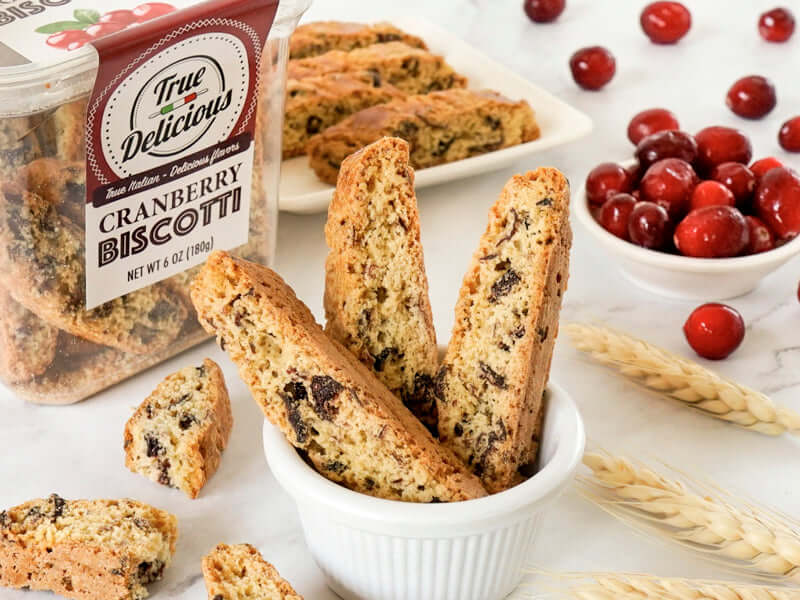What are Biscotti?
Biscotti are traditional Italian cookies known for their distinctive shape and crunchy texture. These twice-baked treats are crafted by forming dough into a log, baking it, slicing it into individual cookies, and then baking them again to achieve their signature crispiness. Originating from Tuscany, biscotti were initially made with almonds, which were abundant in the region. Today, biscotti come in various flavors and styles, each offering a unique twist on the classic recipe.
How is a classic Biscotti recipe baked?
The process begins by baking the dough to cook it through. Once set, the dough is sliced into smaller pieces and baked again. This second bake dries the slices, giving biscotti their signature crunchy texture. This traditional twice-baked method not only provides the distinctive crispness but also extends the shelf life of biscotti, making them stay fresh and tasty for much longer than many other cookies.

Why are Biscotti so Popular?
Versatility: Biscotti can be enjoyed with various beverages, such as coffee, tea, and wine, and come in endless flavor variations, from classic almond biscotti to rich chocolate biscotti or seasonal pumpkin spice biscotti.
Long Shelf Life: Their dry texture allows them to stay fresh for several weeks when stored in an airtight container, making them convenient for storage and gifting, especially during holidays.
Cultural Heritage: Biscotti carry a rich Italian heritage, connecting each bite to a culinary tradition that dates back centuries.
Flavor Varieties: From classic almond to chocolate, hazelnut, anise, pistachio, cranberry, orange, biscotti come in numerous flavors, catering to diverse tastes. This wide range of flavors means there's always something new to try, whether you're making biscotti at home or exploring different varieties from your favorite bakery.
What Does "Biscotti" Mean?
The word "biscotti" comes from the Latin term "biscoctus," meaning "twice cooked" or "twice baked." This name reflects the traditional baking process that gives biscotti their unique texture.
Which Ones Are the Traditional Biscotti?
The traditional biscotti, known as "Cantucci" or "Cantuccini," hail from the region of Tuscany. These classic versions are typically made with almonds and have a simple, yet delightful flavor profile. Over time, various regions and bakers have introduced different ingredients and flavors, but the traditional almond biscotti remain a beloved favorite.

Are Biscotti Crisp or Soft?
Biscotti are known for their crisp texture. The twice-baking process ensures they are thoroughly dried out, giving them a firm and crunchy consistency. This makes them ideal for dunking in coffee, tea, or even dessert wines, as the liquid softens the cookie slightly without making it soggy.
The crispness of biscotti also means they have a satisfying crunch when eaten on their own. This texture sets biscotti apart from other cookies and makes them a unique treat. Whether you're enjoying them as a snack or pairing them with your favorite beverage, the crunch of biscotti is an essential part of the experience.
Are Biscotti High in Calories?
Biscotti are generally lower in fat and calories compared to other cookies because they are typically made with a small amount of butter or oil. However, the calorie content can vary based on the ingredients used. For example, biscotti with chocolate chips, dried fruits, or nuts will have more calories than the plain almond variety. Overall, they are considered a relatively healthy indulgence when enjoyed in moderation.
In addition to being lower in calories, biscotti often contain healthy ingredients like almonds, which are a good source of protein and healthy fats. Some recipes also include dried fruits or seeds, adding to their nutritional value. When choosing biscotti, consider the ingredients and portion size to ensure you're making a healthy choice.
Do People Dunk Biscotti?
Yes, dunking biscotti is a common practice. It's popular to dunk them in coffee or tea. Dunking biscotti is more than just a way to soften the cookies; it's a tradition that enhances the overall experience of enjoying biscotti. The warm liquid brings out the flavors of the biscotti, whether it's the nutty taste of almonds or the rich sweetness of chocolate. Whether you prefer coffee, tea, or wine, dunking biscotti adds an extra layer of enjoyment to this classic treat.

What are other names for Biscotti?
While the term "biscotti" is widely recognized, especially in the context of Italian cuisine, due to the influence of Italian dialects and regional variations, biscotti are sometimes referred to as Biskotti, Biscoti, Biscutt, Biscott, Biskoti, Biskut, Biscuttis, Bescotti, Beskotti, Bisckotti, and Bescoti.
These variations in name reflect the diverse ways biscotti have been adopted and adapted around the world. In some regions, biscotti might be flavored with local ingredients or made to suit different tastes, but the essential process of twice-baking remains the same. No matter what they're called, biscotti are loved for their unique texture and delicious flavors.
Top 3 Most Popular Biscotti Varieties and Recipes
- Traditional Almond Biscotti: The classic choice, perfect for any occasion. These biscotti are made with whole almonds and a touch of almond extract, giving them a rich, nutty flavor that's both simple and satisfying.
- Chocolate Biscotti: A favorite among chocolate lovers, combining the rich flavor of cocoa with the crunch of traditional biscotti. Some recipes add chocolate chips or drizzle melted chocolate on top for an extra layer of indulgence.
- Lemon Biscotti: A refreshing twist with a tangy lemon flavor. These biscotti are often made with lemon zest and sometimes include a lemon glaze for added sweetness.
Biscotti are much more than just cookies; they are a delightful part of Italian culinary tradition with a fascinating history and a range of flavors. Their popularity is a testament to their versatility, long shelf life, and unique texture. Whether you enjoy them plain, almond-flavored, or with a modern twist, biscotti offer a perfect balance of crunch and flavor, making them a timeless treat to savor and share. So next time you reach for a biscotti, remember you’re indulging in a little piece of history!







